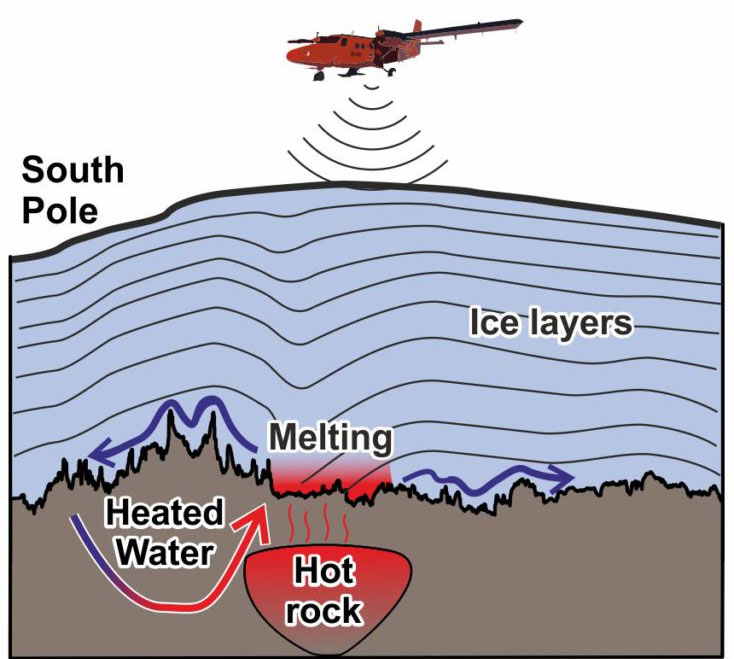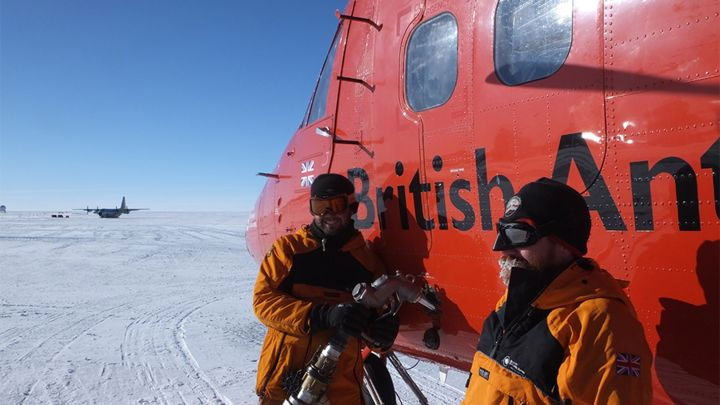The superheated rock
The giant superheated rock in the ground is the cause of an icy area bigger than the lost Rhodes Island in Antarctica.
The British Antarctic Survey (BAS) has used a radar to see through 2.9 kilometers of ice in the area called South Pole , near the southernmost point, to find out the thickness of the ice as well as the underground lakes below. .
As a result, they found the culprit that caused an icy area to suddenly disappear over the island of Rhodes. Rhodes Island has an area of up to 3,144 km 2 .

The diagram simulating the hot rock (red) is melting the Antarctic ice from below - (photo: Tom Jordan).
The icy area had been abnormally melted and scientists had previously suspected that there was a mysterious mysterious geothermal source emerging. Now, through radar image, a radioactive hot stone of 100x500km size has appeared.
Scientist Tom Jordan, a member of the research team, said the process of the said rock melting ice could have taken thousands, even millions of years, silently beneath the permafrost before the Changes can be observed from the surface.

The adventurers on the plane used to capture radar images, discovered the rock - (photo: BAS).
The above process does not immediately change the structure of the Antarctic icy mass in general, but in the long run, excess water due to fusing hot rocks can make this frozen continent more sensitive to gas changes. post.
In addition to hot stones, geothermal springs may also be responsible for this melting.
The result surprised the scientists by previous insights that underneath the permafrost of Antarctic ice is an ancient layer of cold rock that has little effect on the ice above.

Map showing the South Pole hot stone location - (photo: BAS).
This is not the first mysterious heat source in Antarctica. Last year, scientists discovered an ancient heat source called " mantle beam" in West Antarctica, which is also an unusually hot rock rising from the earth's crust, melting solid rock on its way. it. Currently, it does not work vigorously, but in the past, this mantle has ever risen and saved the earth from the ice age.
- Superheated helium balloons,
- Watch the magical rocky area with beautiful ripples
- Revealing the reason why Rock music died young
- 250-ton rock is balanced on a 45-degree steep hill
- How do I always win the game?
- For the first time see rock formations
- Discovered 'coffin' on Mars
- Fans are excited to discover the ancient gods on Mars
- Discovering rocks on Mars has the same composition in Earth
- Mysterious cut bisects rocks over 10,000 years old in Saudi Arabia
- Vietnamese scientist participates in discovering new rock lizard species
- The oldest rock painting on Pharaoh in Egypt
 'Fine laughs' - Scary and painful torture in ancient times
'Fine laughs' - Scary and painful torture in ancient times The sequence of numbers 142857 of the Egyptian pyramids is known as the strangest number in the world - Why?
The sequence of numbers 142857 of the Egyptian pyramids is known as the strangest number in the world - Why? History of the iron
History of the iron What is alum?
What is alum?